Hello.
My name is Robin, and this is my website about computer games. Here you can find essays about old games, industry commentary, free games I've made for fun, and funny songs.

“The reasonable man adapts himself to the world; the unreasonable one persists in trying to adapt the world to himself. Therefore, all progress depends on the unreasonable man.”
George Bernard Shaw, again
In the previous post, I complained about the Dead Space franchise, and the prevalence of “pot-boilers” in publisher’s catalogues – games that tick genre boxes but don’t set their sights on doing anything genuinely exciting and new. A few years ago, these games would have taken the form of direct imitations of successful titles, such as the glut of mediocre Doom, C&C and GTA clones. These days developers are more likely to cherry pick ideas from several different games, but the net result is the same.
With so much of the industry engaged in this kind of short-term thinking, is it possible to find a counter-example – a studio that is actually trying to challenge the status quo whose projects are part of a more sophisticated long-term plan than to just make incrementally improved sequels?
I think there are at least a few companies for whom a strong case could be pleaded. One of these is Dundee’s Real Time Worlds (RTW). They are currently working on an online action game for the PC called APB, due for release some time in 2010.
Tags: apb, david jones, game title, GTA, MMO, mmorpg, PC, real time worlds, rtw, WoW
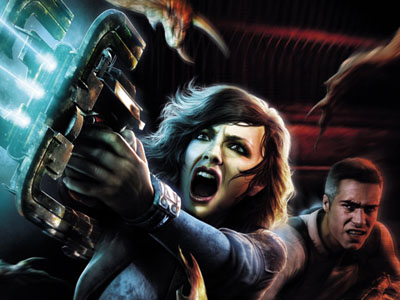
“Criticism written without personal feeling is not worth reading. It is the capacity for making good or bad art a personal matter that makes a man a critic. The artist who accounts for my disparagement by alleging personal animosity on my part is quite right: when people do less than their best, and do that less at once badly and self-complacently, I hate them, loathe them, detest them, long to tear them limb from limb and strew them in gobbets about the stage.”
George Bernard Shaw
I think we can assume that if he were alive today George Bernard Shaw would not be making a living previewing computer games. Previews are all about cautious optimism. Publications don’t want to dash their readers’ hopes of forthcoming games before they’ve had a chance to read the full review. Nor is it unheard of for a game to improve dramatically in the time between journalists seeing an unfinished preview version and the final article (sometimes as a result of feedback from previewers and beta testers). The main purpose of a preview is raising awareness and answering the most likely questions – strict editorial judgement (hopefully) comes later.
While this is all perfectly reasonable (even though it apparently came as an astounding revelation to some people who’ve presumably never read a games magazine in their lives), it doesn’t really look at the big picture. Developers are seldom asked why they’ve decided to make a particular game, and whether in artistic terms that’s the right direction to go in. Probably because these are quite pseudy questions.
Regardless, in the next two posts, I’m going to look at two forthcoming games (neither of which I’ve played yet) and try to explain why the mere concept of one of them fills me with irrational fury, while the other fills me with giddy hope for the future of the medium.
Tags: dead space, dead space extraction, ea, resident evil 4, wii

It must be incredibly frustrating for a developer to deliver a game that convincingly nails its design goals, only to see it flounder in the marketplace for reasons beyond their control. This sometimes happens when another game in the publisher’s portfolio has become a smash hit, leading everything else to be neglected regardless of quality. In other cases, the staff who set up and evangelised the project go elsewhere and their replacements don’t share their enthusiasm. Or it could simply be that the game targets a platform or genre where the publisher lacks experience. It’s this last scenario that seems to have soured the fortunes of Grand Theft Auto: Chinatown Wars, Rockstar Games’s first title for the Nintendo DS.
If we consider the hesitant way in which it has been marketed, combined with assumptions about the technical capabilities of the host platform, it’s likely that many potential purchasers have been led to assume that Chinatown Wars is a spin-off sharing no similarities to the 3D GTA games beyond the brand name. The packaging features softer, more cartoon-like artwork than most of the GTA games and a single, thumbnail-sized screenshot of the in-game graphics on the reverse. Even in screenshots and video, the game looks far removed from GTA IV or the rest of the 3D GTAs, lacking the rich colours, iconic screen furniture and sweeping cityscapes that have been the series’s hallmarks since GTA III.
Let’s set this straight once and for all: GTA:CW is a 3D GTA game. It is not a return to the presentation and game mechanics of the 2D GTAs. In mechanical terms, the game plays extremely similarly to GTA III or Vice City (except with the benefit of many new features and refinements, such as being able to restart missions easily and save anywhere). The main technical differences are the camera (which has a locked pitch, limiting the required drawing distance as the game has no LOD system) and the use of sprites instead of polygons for all the little people. There are also no flyable aircraft or 3D building interiors, and cut-scenes are presented in text and still images rather than voiced, motion-captured animations. Aside from that, everything you can do with a weapon, car, bike or boat in the home console GTAs is present and correct in Chinatown Wars.
(more…)
Tags: Game, game title, grand theft auto, grand theft auto: chinatown wars, GTA, nintendo ds, rockstar, wonsu nodong
The E3 press conferences have now passed and industry watchers are busy digesting the glut of information. There is now some form of motion-based control interface announced for each of the three home consoles. Each of these takes a different technological approach, and perhaps more importantly, each is perceived to address a different role by its manufacturer. It’s also worth bearing in mind that none of these projects have been started with a blank slate, with the pre-existing Wii Remote, Playstation Eye and 3DV Systems’ ZCam dictating their respective manufacturer’s approaches significantly.
As these are the first attempts at a motion control system of this level of complexity, and because they’re patched together on top of existing technology, it’s likely that none of them represents the final stage in this particular arms race. In a few years time the console manufacturers will be able to look back on what worked and what didn’t and synthesise these elements into a new pseudo-standard, much as the various joypad controllers gravitated towards subtle variations on the Dual Shock.
Below are some thoughts on the possible strengths and weaknesses of each offering at this early stage. Of course the true test will be whether developers can find good uses for these tools and whether consumers can be persuaded to buy into them. The reception Wii Sports Resort has seen so far suggests that there is still an appetite for new control experiences.
Tags: commentary, e3, microsoft, motion control, motion controller, nintendo, project natal, sony, wii motion plus
A few hours ago Microsoft held their E3 press conference. It was a low key affair as these things go. A slate of solid-looking third- and first-party games were trailed, with a couple of surprise announcements that were vague enough to be enthusiastically overstated. (The MGS reveal, for example – obviously not an exclusive, possibly not helmed by Kojima, and not entirely clear where it lies on the spectrum between a whole new game and a Substance/Subsistence-style re-release, but extravagantly touted as the fall of the ‘last’ franchise still holding out from the 360. And how many discs is it going to be on?)
The highlight of the presentation for me was the unveiling of Microsoft’s new controller peripheral, codenamed “Project Natal”. This device could be summed up as Eyetoy on steroids. It was presumably commissioned as a response to the Wii Remote and Wii Fit (the runaway success of the latter no doubt emboldening Microsoft to consider an expensive peripheral that is sold separately from the console).
The technology that was shown (gesture, voice and face recognition) was undoubtedly impressive. But as the demonstration went on I began to suspect that the strategists who had overseen it (the same people who were up on stage last year enthusing about Lips, Scene It! and You’re in the Movies perhaps?) have tried to find rationales for the technologists’ ideas rather than making decisions from the users’ perspective.
The Wii Remote wasn’t a success because it had a long feature list. Like the Walkman, it was a product of taking away anything that got in the way of the core functionality. The result was a device general enough to support almost any existing game genre (fighting and racing games being problematic), while still offering enough accessible motion-based control to be engaging to a non-gaming audience. Essentially, it’s a mouse you can use from the sofa.
Tags: commentary, e3, microsoft, project natal, xbox 360

Ten years since I started regularly writing words on the internet it has occurred to me that there might be people willing to offer me money to do this. The first fruits of this experiment can now be viewed on Eurogamer, where I’ve contributed a piece to their regular Sunday morning retro strand about the PC shareware scene of the 1980s and 1990s.
“How could the complacent PC games industry be shaken out of its torpor? Such a task called for nothing less than a revolutionary movement – an underground development scene, answerable to no marketing departments and dismissive of hidebound conventions about what PC users would consider ‘worthy’ uses of their sacred beige monoliths. Their success would hinge on the creation of fast, fluid, immersive games that would thrust the PC into the limelight and make Amiga owners involuntarily hiss with envy. Games, in a nutshell, like Doom.
“That movement was known as Shareware.”
(Read the full article on Eurogamer.)
Due to a chance sequence of events I first started playing games on the PC in 1987, so grew up more immersed in that scene than most UK and European games folk, who mostly went straight from the ZX Spectrum, BBC Micro and C64 to the Amiga and ST, and only turned to the PC when it became obvious that the Amiga was over the hill.
Writing this piece allowed me (through the wonders of DOSBox) to rediscover a lot of games that I’d completely forgotten about. It also confirmed my suspicions that the amount of information online about PC games of this period is alarmingly thin on the ground. If I’d wanted to write about the NES or the golden age arcade games I’d have had lots of sources to draw from, but in this case I had to rely on Apogee’s own retrospectives and the wild and woolly cd.textfiles.com to supplement my own hazy memories.
Tags: apogee, commentary, DOS, epic, eurogamer, id, PC, shareware

Cubello is one of Nintendo’s “Art Style” games, a franchise of simple puzzle games (mostly developed by skip Ltd.) with stylish minimalist presentation that developed from the “bit Generations” series which accompanied the launch of the Game Boy Micro. It’s currently available to purchase through the Wii Shop Channel* in Europe and North America for a very reasonable 400 Wii Points (about three quid).
While Cubello might not be that remarkable in itself, its a good example of the sort of game that wouldn’t have been possible before Nintendo’s Wii-reinvention. During the last hardware generation, Nintendo not only had no online strategy, but also no satisfactory way to sell small games. (Their much-maligned offering of NES games for the GBA as individual cartridges being typical of their approach.) They’ve since embraced digital distribution for both the Wii and DSi.
What’s more, Cubello’s interface is built around the Wii Remote’s cursor function. There has been surprisingly little recognition of the significance of this aspect of the Wii’s controls. Making a pointing device work from the sofa is a prize that has eluded console manufacturers for decades, confining many mouse-driven games and genres to the PC. While the Wii Remote is marginally less responsive and accurate than a mouse, it’s light years ahead of an analogue joystick for pointing (and aiming, and drag-and-drop) tasks.
So anyway, what is it that you do with the cursor in this cheap yet stylish game?
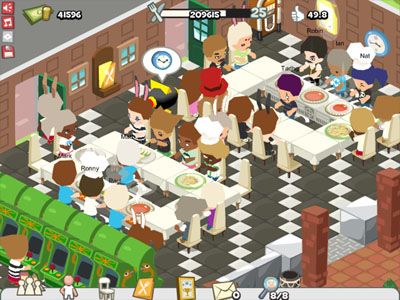
I’ve noticed there currently a lot of interest in Restaurant City (a Facebook game which I discussed earlier) so I’ve compiled my top five tips to successful restaurant management. All of this information (and much more) can be found by digging around the FAQ and the game’s forum, but these are the basics which will help you avoid frustration early on.
1. Make sure you have some friends playing.
Your progress will be drastically slower if you don’t have at least a couple of Facebook friends registered and actively playing the game. Yes, it’s contrived to make you market the game for them, but hey, at least the game’s free.
2. Only spend money on necessities.
Decorations can come later. Your primary objective is to earn cash and XP quickly. Most of the things that the game offers to sell you drain cash without giving any benefit to your earning ability.
You need to unlearn the habits of other management games. Restaurant City isn’t as sophisticated as Theme Park, The Sims or Animal Crossing in this regard. There’s no “Feng Shui”. Most of the stuff you can buy doesn’t have any impact on how well your restaurant works or your customers’ wellbeing. The only things that you should worry about early on are the placement of tables, chairs and stoves and the stamina of your staff.
(more…)
Tags: facebook, Game, guide, playfish, restaurant city, tips
The United Kingdom has had an incredibly rich history as a producer of video games. Historically we’ve been the only country outside of the US and Japan to have consistently enjoyed international success (although South Korea and China are on their way to joining us at the top table).
Even though the UK games industry (like all our entertainment industries) takes pains to superficially ‘Americanise’ its output (to the extent that games like Grand Theft Auto IV are routinely assumed to be US-made), it can’t disguise the deeper idiosyncracies: UK developers grew up playing different games to their American and Japanese counterparts, and UK companies have a different culture and working methods, resulting in games that could not emerge anywhere else.
Sadly these disproportionate achievements go unrecognised by the UK government. The Department of Culture, Media and Sport (which you’d think would be triply interested in games) has recently been talking up “Digital Britain“, and how the government “plan to secure Britain’s place at the forefront of the global digital economy.” This seems to be more concerned with protecting the interests of recording and broadcast content providers than acknowledging that games exist in any way, shape or form. The interim report that they’ve issued is a completely extraordinary document in this respect, like something from a parallel universe. Their only mention of games is in the context of last year’s Byron Report, a bit of populist froth which has come dangerously close to lumbering games with even more expensive, damaging censorship. Games are viewed as a bogeyman rather than a significant contributor to the economy.
While the UK government grapples with the question of whether games are a corrupting influence on ‘youth’, many other industrialised nations (whose political elites presumably don’t exclusively consist of clueless grasping Luddites) are actively funding and encouraging the growth of their games industries. Canada, France and South Korea all offer significant tax incentives to attract businesses to their shores. I noticed this week that even Australia (where it’s still illegal to sell 18-rated games) have mechanisms in place to channel public money towards game development, as can be seen in the well-publicised and enthusiastically received Scarygirl.
Nearly every British film I’ve seen in the last decade has been part-funded by the Lottery. Why don’t UK games developers have access to Lottery money? Why can’t we get tax breaks for work that have proven to have far greater international marketability than our TV and film businesses? As far as I’m aware (and admittedly I’ve not researched this exhaustively) there are no schemes set up to support games companies in this way.
I accept that there are strong arguments against ‘bailing out’ industries that can’t compete on their own merits, and that some of the actions taken in other countries (particularly Canada) are excessive and may not result in an industry that will want to stick around if the tax incentive is taken away. But surely we can at least expect a level playing field with other media?
If tax breaks aren’t the answer, maybe there are other ways that the government could try to safeguard the viability of the industry. There could be a complete package of resources in the form of education, training, guidance for start-ups, forums for easier cross-industry sharing of expertise and resources, and schemes to ensure the management staff of games companies have appropriate business training. Help the industry grow up and maximise the opportunities for creative people to succeed.
While the games industry’s trade bodies are actively lobbying the government to improve the situation, I think that there is an opportunity for developers, publishers, websites and sympathetic gamers to raise awareness of the problem to the public and the media. I imagine some media outlets would be keen to highlight the discrepancy between the government’s pledges to support the “digital economy” and their actions. There’s a slim chance that this would spur some unusually technically literate MP to champion the issue, but at the very least it would be good PR.
To this end, I propose a consumer branding program. Where films proudly announce their Lottery-funded status, UK games could display something like:
☹
MADE (WITH NO PUBLIC SUPPORT) IN THE UK
(Obviously not this, but something like it, preferably with a memorable logo, slogan and URL attached.)
Any game made in the UK with no public money (i.e. most/all of them) would be eligible to carry this logo (although it would be more realistic to expect makers of independent PC/web games to consider it than major publishers). It would be backed with a website encouraging players to sign a petition, write to their MP, or bore people about the problem at dinner parties tell their friends. Nearly everyone who uses a computer comes into contact with games in some way (through Facebook or email forwards at least), so this approach would expose the issue to a far broader audience than fretting about it in the trade press.
Is this a good idea? Would people understand it? Or does the average gamer simply not care about the difficulties faced by developers and publishers (let alone where they’re based), just as long as they get to play new games?
Tags: commentary, digital britain, games, tax breaks, uk
“Braid treats your time and attention as precious.”
Braid official website
The PC version of Jonathan Blow’s arty platform puzzler Braid came out last week, complete with a demo. Much praise has been lavished on this game since its original release on the Xbox 360 last year. I’ve not caved in and paid for the full game yet, mainly because the demo suffered from some fundamental technical issues which virtually every other PC game released in the last 20 years has been able to successfully negotiate. Specifically:
- The game only supports a single resolution, aspect ratio and refresh rate. (Updates have added command line parameters to force other resolutions, but unless you have a 1280x720px monitor, there’s no satisfactory way to run the game full screen and scaled correctly.)
- The game does not support generic PC joystick devices. (Only Xbox 360 joypads and keyboard are supported.)
- The game does not allow the controls to be remapped, either in-game or through a configuration file. (If you’re left-handed or using a laptop without conveniently placed arrow keys, shift and space, then sorry, you’re out of luck.)
For the first of these, we can give the developer the benefit of the doubt. Braid would hardly be the first game to be built on the assumption of fixed screen dimensions. If the Xbox 360 version had been a flop, there would likely never have been a PC port and this issue would never have arisen. (That said, it does make me wonder how the Xbox 360 version handles 4:3 and standard definition televisions.) It’s irritating, but not a deal breaker.
There is no excuse for either of the other two issues. It is completely reasonable to expect to be able to configure the controls for a game, and for it to support the player’s preferred (standardised) input device, without having to resort to third-party utilities. The overwhelming majority of games ever released on the PC (and before that the 8-bit and 16-bit home computers) have supported these options.
The only explanation that I’ve seen regarding these issues is that Blow didn’t want to have to change the “tooltip” graphics which prompt which button the player should press when each new mechanic is introduced during gameplay. I hope that this isn’t true, as it would suggest that his priorities are very badly muddled. (Also, surely if this was the sticking point, it could be overcome by referring to the buttons by generic labels – i.e. ‘JUMP BUTTON’ and ‘REWIND/ACTION BUTTON’ – and if there was any further worry about thick people getting confused, automatically prompting the player the option to redefine the controls on detecting a joystick.)
With so many games being developed concurrently for the PC and ‘next-gen’ consoles these days, there is an insidious trend for the more subtle differences between the platforms to be ignored. Fallout 3 (and Oblivion) presents its UI in enormous fonts designed to be readable from the sofa across the room from the screen. Dead Space and Bioshock (and countless other games) instruct PC players not to remove the storage device or switch of the power while saving. Devil May Cry 4 comes with an external utility to configure joypads, which quickly turns into an exciting (and potentially unwinnable) game of ‘guess the axis’ if you don’t have the exact model of joypad the developers used internally. Usually these are minor inconveniences, but Braid’s problems go beyond that. Will these problems get worse if the trend continues unchecked?
It shouldn’t be that hard to anticipate the most common ways that PC users will want to configure a game. King’s Bounty (discussed previously) is particularly smart in this regard, detecting the desktop resolution and allowing the game to be cleanly task-switched using Alt-Tab without struggling or crashing.
And another (final) thing! I seem to recall Jonathan Blow has previously publicly moaned about the burden of technical requirements and QA testing required to get a game onto Xbox Live Arcade. If the PC version of Braid is anything to go by, perhaps it’s just as well that Microsoft were breathing down his neck to enforce some baseline user interface niceties.
Tags: Braid, doing it wrong, Game, PC
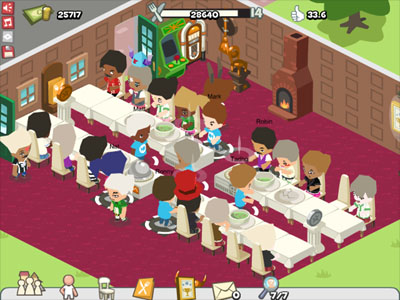
There are some games that should be kept out of the hands of people with addictive personalities. For me, Card Fighters Clash was one. Kingdom of Loathing, for a time, was another. And don’t get me started on Animal Crossing: Wild World – everything UK:Resistance say about the game is true (and if anything an understatement). Given this history I daren’t even approach World of Warcraft.
The rewards offered by these games, shorn of context or emotional investment, are not immediately apparent to the outside observer. A few games take this a step further, leaving the players themselves without an adequate explanation as to why they’re drawn into the game. Sometimes it’s enough to see a number get bigger. A case in point: Restaurant City, the latest game from Flash-games-for-social-networks supremos Playfish. This is a game that offers very little in the way of traditional gameplay, but I still can’t stop going back to it.
Tags: addictive, animal crossing, facebook, Game, game title, playfish, restaurant city
An Ice Cream Van (or Ice Cream Truck in American English) is a mobile ice cream parlour, typically painted with gaudy images of frozen treats and/or unlicensed Disney characters. Ice cream vans are driven around residential areas to dispense ice cream cornets, lollies and cans of fizzy pop. I’m sure we all have fond childhood memories of pestering our parents for money on hearing those familiar chimes, and being told that the music means that they’ve run out of ice cream. Right?
Games developers have long realised the comedic potential of these preposterously decorated vehicles and have frequently included them in the rosters of driving and racing games over the years. Nothing unusual in that you might think. But a few years ago games researchers noticed a curious phenomenon: games containing ice cream vans consistently recieved more favourable review scores than their ICV-less peers.
The following case studies show the “Ice Cream Van Theory” in action. Note that there are many more that we could have picked (including Micro Machines V3, Twisted Metal, Test Drive: Le Mans, Tony Hawk’s Pro Skater 3, Interstate ’76 Nitro Riders and Carmageddon 64), but some of them aren’t very good.
Grand Theft Auto Vice City
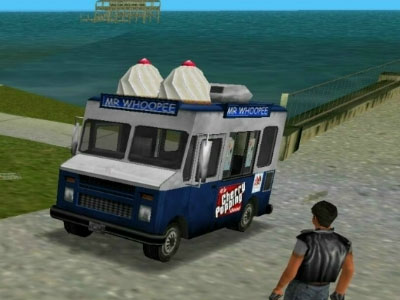
While several of the GTA games have featured ice cream vans, they featured most prominently in Vice City, where it’s possible for the player to take control of an ice cream/illicit drug distribution business. The vans can be used to perform optional bonus missions (as with taxis, police cars, fire trucks and ambulances), activating the chimes to attract punters while looking out for the cops.
The House of The Dead: Overkill
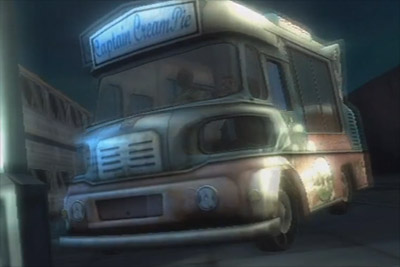
Sega/Headstrong’s exploitation cinema themed light-gun shooter includes a minor running gag of having the protagonists’ cars being blown up. After this happens the second time, the duo steal an ice cream van from a funfair to continue the chase. A small role, but one that shows Headstrong are aware of this widely held industry superstition.
Toejam & Earl

One of the earliest recorded in-game sightings, the “Phantom” ice cream vans that inhabit Toejam & Earl’s surreal version of planet Earth are extremely malevolent, capable of materialising from thin air and flattening hapless players like a pancake.
Elite

There are no verified sightings of any ice cream vans (or futuristic spacefaring equivalents, or planets inhabited by sentient ice cream vans, or any other types of vans, or ice cream) in the space trading classic Elite. However, as nobody (as far as we know) can claim to have explored every nook and cranny of Elite’s eight galaxies, there could be one out there. This would explain why Elite has never been bettered in its genre.
So there you have it. Having exhausted World War II, Vietnam, zombies, and gratuitous use of the word “fuck” as surefire ways to draw in the punters, the time is now ripe for games publishers to jump aboard the frozen confectionary bandwagon. Codemasters are already rumoured to be following up GRID and FUEL™ with FLAKE™, Atari are planning A Cone in the Dark, Namco for their part offer Soul Calippo and this is now risking turning into a Listopia feature.
Inspired by this piffle.
Tags: commentary, elite, grand theft auto vice city, ice cream van, science, the house of the dead: overkill, toejam & earl

This is something that doesn’t happen enough these days: stumbling across a new, unheralded game and then not being able to stop playing it, for the rest of the afternoon, until it’s beaten. And then blogging about it to enthuse about how awesome it is.
The game in question is Knightfall, a new Flash-based puzzle game from Megadev, a Southampton-based casual games developer who were previously responsible for Guitar Geek. On the basis of their output so far, I would predict they’re destined for greatness, or at least a good run at the iPhone App Store, WiiWare, DSiWare, XBLA and PSN.
Knightfall presents a grid of 9 x 9 coloured tiles, three spaces on which are taken up by a knight, a door and a key. The player can click on groups of three or more like-coloured tiles to make them disappear, causing anything resting on them to fall in accordance with what we call ‘gravity’. The player can also rotate the board in 90 degree increments. The object of the game is to direct the knight to the key and then to the door. This task is complicated by monsters who will attack the knight if he gets too close (the triggering distance and directions depending on the type of monster), and which can only be safely dealt with by arranging for the knight to fall on them from above, pranging them with his lance. There’s a light smattering of RPG elements – the game awards gold and XP during play and lets the player buy equipment and item from a shop after every fifth level – but these boil down to providing more health points, and thereby allowing the player to get away with making more mistakes.
The game is clearly influenced by Mr. Driller, Puzzle Quest, Boulderdash and (visually) Ghouls ‘n Ghosts, while offering gameplay that is original and distinct from any of those. The randomly generated levels and the brutal amount of damage dished out by enemies (playing at normal difficulty) mean that careless play is rapidly rewarded with the Game Over screen. The main issue with the game as it stands is one of balance – the degree of randomness results in many levels ending in an unavoidable stalemate and having to be attempted repeatedly, and there are extremely few health powerups offered between shops. The final boss is no pushover either – it took me several dozen attempts to finally beat him. (I only had enough health to sustain one attack by that point, but it would have been unsportsmanlike – and tiresome – to replay the whole game in an attempt to stockpile more potions.)
The presentation is well above the typical standard for a Flash game (only marred by an ugly blurring effect when the board is rotated, but it’s barely noticable). The campaign mode is just long and challenging enough to give a sense of achievement without outstaying its welcome. I hope they’re considering an extended ‘premium’ version (either on PC or the other platforms I mentioned earlier), if only to give me an excuse to play it some more.
Tags: addictive, flash, Game, game title, guitar geek, knightfall, megadev, mr. driller, puzzle
A quick update to condemn this idiocy:

“The Government’s Change4Life campaign upped the ante in drawing spurious links between games and premature death this week.
The British Heart Foundation, Diabetes UK and Cancer Research have all lent their name to a new print campaign (pictured here), which shows a gamer risking an early grave by ‘doing nothing’. It has appeared in women’s lifestyle press titles such as Star, Reveal and Heat.”
– MCV
Perhaps one day we will have politicians in this country whose approach to modern technology doesn’t resemble a drunken chimp trying to play Kerplunk! while wearing boxing gloves.
You can complain to the ASA here, and join the Facebook group here.
Update: Why are cakes and games lethal, specifically? Because the campaign is funded by fast food and television companies. How pathetic.
Tags: cakes, commentary, fail, games, government, health, obesity, scaremongering
There has been a growing trend of late to try to revitalise brands by tenuously affiliating them with video games. American gamers have been wooed with snacks, soft drinks and (erm) shaving products which are somehow conducive to the gamer ‘lifestyle’. The people at the Guinness Book of World Records (presumably facing dwindling sales in the lean years since Kriss Akabusi and Cheryl Baker kept record breaking high on the cultural agenda) decided to jump on the bandwagon last year, with the Guinness World Records Gamer’s Edition. Now in its second edition, the book may be a more legitimate attempt to appeal to gamers than razor blades and fizzy water, but there are still some significant problems with the implementation.
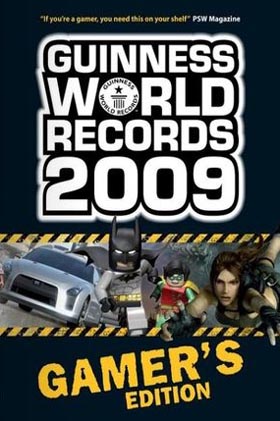
On the face of it, the concept of a book of gaming records is a sound one. Competitive gaming records (i.e. high scores) have in fact been covered by a book called Twin Galaxies since the 1980s, which is the source of most of the records of this nature in the Guinness book. However, as a book consisting solely of tables of numbers would be boring to Guinness’s youth demographic, their team of researchers have relaxed the definition of a ‘world record’ to cover lots of sales figures and other bits of gaming trivia.
The problem with this approach is that to obtain usable information (as well as screenshots and artwork, and possibly access to developers), Guinness have had to approach publishers’ PR departments. Publishers generally don’t employ full time historians to field less obvious enquiries, and inevitably a lot of the information that they’ve been provided with is more concerned with promoting their current slate of releases than accuracy or suitability for a book of this type.
Tags: books, commentary, dedication, guinness, guinness world records, nitpicking, PR
